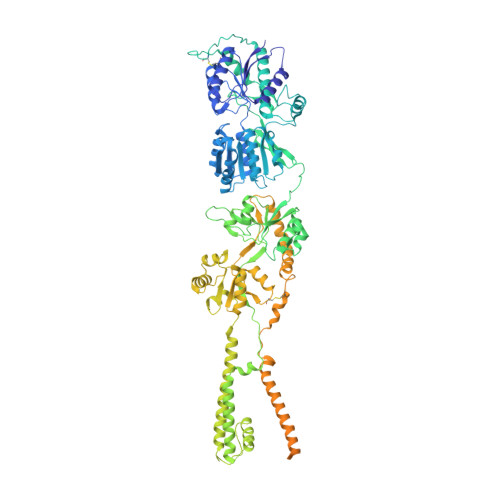Structural Bases of Desensitization in AMPA Receptor-Auxiliary Subunit Complexes.
Twomey, E.C., Yelshanskaya, M.V., Grassucci, R.A., Frank, J., Sobolevsky, A.I.(2017) Neuron 94: 569-580.e5
- PubMed: 28472657
- DOI: https://doi.org/10.1016/j.neuron.2017.04.025
- Primary Citation of Related Structures:
5VHW, 5VHX, 5VHY, 5VHZ - PubMed Abstract:
Fast excitatory neurotransmission is mediated by AMPA-subtype ionotropic glutamate receptors (AMPARs). AMPARs, localized at post-synaptic densities, are regulated by transmembrane auxiliary subunits that modulate AMPAR assembly, trafficking, gating, and pharmacology. Aberrancies in AMPAR-mediated signaling are associated with numerous neurological disorders. Here, we report cryo-EM structures of an AMPAR in complex with the auxiliary subunit GSG1L in the closed and desensitized states. GSG1L favors the AMPAR desensitized state, where channel closure is facilitated by profound structural rearrangements in the AMPAR extracellular domain, with ligand-binding domain dimers losing their local 2-fold rotational symmetry. Our structural and functional experiments suggest that AMPAR auxiliary subunits share a modular architecture and use a common transmembrane scaffold for distinct extracellular modules to differentially regulate AMPAR gating. By comparing the AMPAR-GSG1L complex structures, we map conformational changes accompanying AMPAR recovery from desensitization and reveal structural bases for regulation of synaptic transmission by auxiliary subunits.
Organizational Affiliation:
Department of Biochemistry and Molecular Biophysics, Columbia University, 650 West 168(th) Street, New York, NY 10032, USA; Integrated Program in Cellular, Molecular, and Biomedical Studies, Columbia University, 650 West 168(th) Street, New York, NY 10032, USA.
















